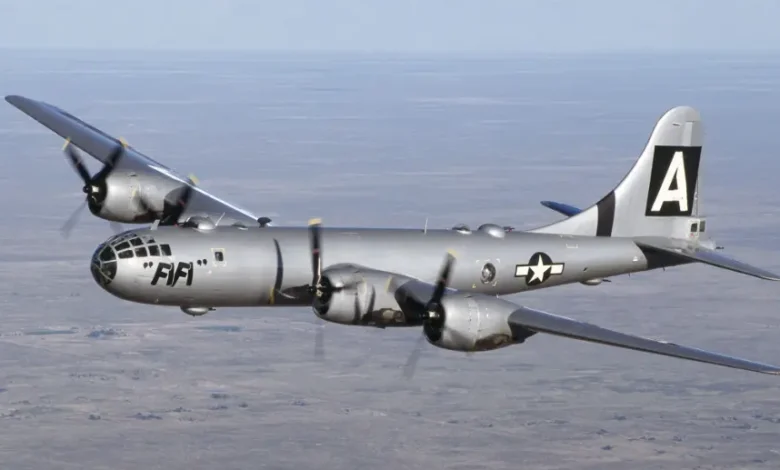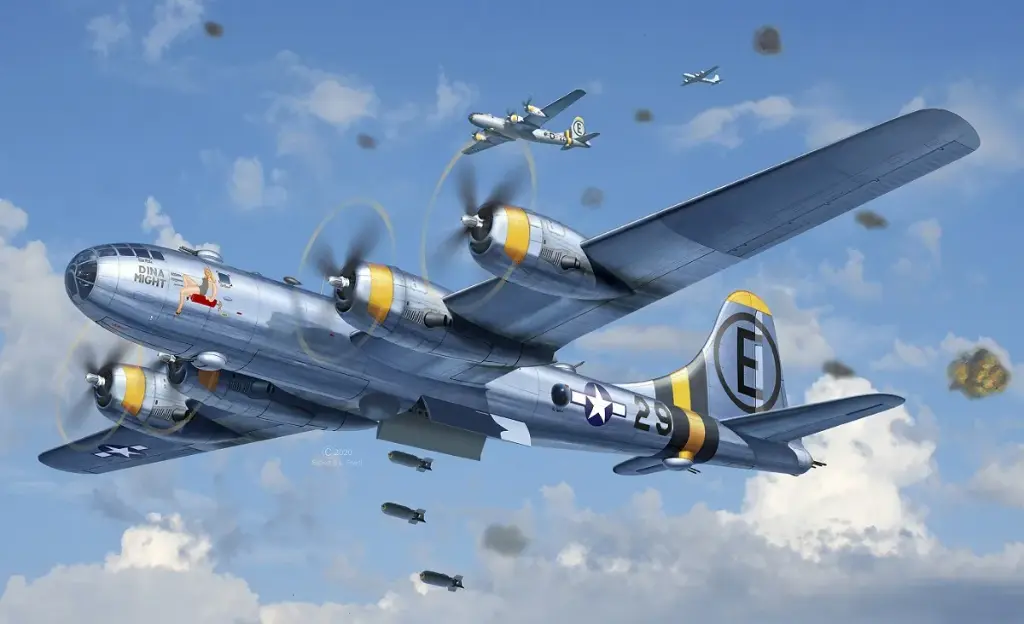Boeing B-29 Superfortress

The Boeing B-29 Superfortress was a revolutionary American heavy bomber used during World War II and the Korean War. Known for its advanced technology, including pressurized cabins and remote-controlled gun turrets, the B-29 was instrumental in strategic bombing campaigns. It is most famous for dropping atomic bombs on Hiroshima and Nagasaki, effectively ending World War II.
Fact Sheet
| Role | Heavy Bomber |
|---|---|
| Manufacturer | Boeing |
| First Flight | September 21, 1942 |
| Service Entry | 1944 |
| Crew | 11 |
| Number Built | 3,970 |
Specifications (B-29 Model)
| Length | 99 ft (30.2 m) |
|---|---|
| Wingspan | 141 ft 3 in (43 m) |
| Height | 27 ft 9 in (8.46 m) |
| Wing Area | 1,736 sq ft (161.28 m²) |
| Empty Weight | 74,500 lb (33,800 kg) |
| Loaded Weight | 120,000 lb (54,400 kg) |
| Max Takeoff Weight | ~133,500 lb (60,560 kg) |
| Powerplant | 4 × Wright R-3350 Duplex-Cyclone radial engines (2,200 hp each) |
| Max Speed | 357 mph (575 km/h) |
| Cruise Speed | 220 mph (350 km/h) |
| Range | 3,250 mi (5,230 km) with 20,000 lb bomb load |
| Service Ceiling | 31,850 ft (9,700 m) |
| Rate of Climb | 900 ft/min (4.57 m/s) |
Armament & Defensive Equipment
| Guns | 10 × .50 in (12.7 mm) M2 Browning machine guns, 1 × 20 mm cannon |
|---|---|
| Bomb Load | Up to 20,000 lb (9,100 kg) |
| Aiming Equipment | Norden bombsight and remote-controlled gun turrets |
Notable Features
- Pressurized crew compartments for high-altitude operations
- Remote-controlled defensive gun turrets with advanced targeting systems
- Famous for the atomic bomb missions over Hiroshima and Nagasaki
- Long range and high payload capacity for strategic bombing
- Used extensively during the Korean War

Boeing B-29 Superfortress: The Pacific War’s Game Changer
The Boeing B-29 Superfortress was a revolutionary American four-engine, propeller-driven heavy bomber designed and built by Boeing. It was one of the most advanced and expensive weapons systems of World War II, playing a pivotal role in the final strategic bombing campaigns against Japan, including the atomic bombings of Hiroshima and Nagasaki, and continued to serve in the Korean War.
B-29 Development & Production: A Wartime Marvel
The development of the B-29 began in the late 1930s (officially in January 1940), driven by the United States Army Air Corps (USAAC) requirement for a long-range, high-altitude bomber to operate in the vast distances of the Pacific theater. Boeing’s Model 345 design, with its unprecedented size and advanced features, won the contract.
The first XB-29 prototype flew on September 21, 1942. The B-29 project was the single most expensive project of World War II at an estimated cost of $3 billion (over $41 billion in 2018 dollars), surpassing even the Manhattan Project. Production was a monumental undertaking, spread across multiple facilities: Boeing’s own plants in Wichita, Kansas, and Renton, Washington, and licensed production by Bell Aircraft in Marietta, Georgia, and Glenn L. Martin-Nebraska in Omaha. This distributed “multi-line assembly system” was a revolution in manufacturing, with nearly 3,970 B-29s produced by the end of its production run in 1946.
B-29 Design Features: Technological Innovations
The B-29 was a technological marvel for its time, incorporating several cutting-edge features:
- Pressurized Cabins: A groundbreaking innovation for a production bomber, the B-29 featured three pressurized compartments (forward, central, and tail gunner’s station) connected by a long tunnel over the unpressurized bomb bays. This allowed the crew to operate at high altitudes (up to 30,000 feet, where Japanese fighters struggled to reach) without constant oxygen mask use, significantly improving comfort and reducing fatigue on long missions.
- Remote-Controlled Defensive Turrets: The B-29 pioneered a General Electric Central Fire Control (CFC) system. This analog computer-controlled system allowed a single gunner to operate and direct multiple remotely controlled turrets, each armed with two .50 caliber (12.7 mm) M2 Browning machine guns. There were five sighting stations (nose, tail, and three Plexiglas blisters in the fuselage), allowing gunners to switch control of various turrets depending on the threat. This maximized defensive firepower and coordinated fire.
- Dual Bomb Bays: The aircraft featured two separate bomb bays in the unpressurized central section, capable of carrying a significant bomb load.
- Efficient Aerodynamics: Boeing paid exceptional attention to the B-29’s aerodynamics, streamlining its fuselage, wings, and reducing protrusions like the gun turrets to minimize drag. Flush-head rivets and butt-seamed skin panels further contributed to its clean design.
- Four Wright R-3350 Duplex-Cyclone Engines: Powered by four massive Wright R-3350 eighteen-cylinder air-cooled radial engines, initially producing 2,200 hp each. These engines, while powerful, were also prone to overheating issues, a persistent problem throughout the B-29’s operational life.
- Tricycle Landing Gear: The B-29 was one of the first heavy bombers to feature a dual-wheeled tricycle landing gear, aiding ground handling.
B-29 Variants: Evolution and Specialization
While the B-29 didn’t have as many external variants as some other WWII bombers, several key versions and post-war modifications existed:
- XB-29: The initial prototypes.
- YB-29: Service test aircraft.
- B-29: The standard production bomber, built by Boeing-Wichita, Martin-Omaha, and Bell-Atlanta.
- B-29A: Produced by Boeing-Renton, featured a stronger, three-section wing and often a four-gun forward upper turret instead of two.
- B-29B: A stripped-down variant built by Bell-Atlanta for low-altitude incendiary bombing. It removed all remote-controlled turrets (except the tail gunner, often with a 20mm cannon and radar-controlled sighting) to save weight and increase speed and bomb load.
- B-29C/D (later B-50): These were proposed and later produced as the Boeing B-50 Superfortress, a significantly upgraded B-29 with more powerful Pratt & Whitney R-4360 Wasp Major engines, a taller vertical stabilizer, and structural improvements, enabling faster speeds and higher altitudes.
- F-13/F-13A (later RB-29/RB-29A): Photographic reconnaissance variants.
- SB-29 “Super Dumbo”: Air-sea rescue variant, modified to carry a droppable life raft.
- WB-29: Weather reconnaissance variant.
- KB-29M/P: Aerial refueling tanker variants, using either the probe-and-drogue (M) or flying boom (P) systems.
- EB-29: “Exempt” variant used as a mothership for launching experimental aircraft like the Bell X-1.
B-29 Armament & Bomb Load: Devastating Power
The B-29’s offensive and defensive capabilities were formidable for its era:
- Internal Bomb Load: Standard B-29s could carry up to 20,000 lbs (9,072 kg) of bombs over shorter ranges or around 12,000 lbs (5,443 kg) for its typical long-range missions against Japan. It was capable of carrying all types of conventional bombs, including high-explosive, incendiary, and even naval mines.
- Defensive Armament:
- Typically 10-12 .50 caliber (12.7 mm) M2 Browning machine guns in five remotely controlled turrets (two upper, two lower, one tail).
- Early models also included a single 20 mm M2 cannon in the tail turret, sometimes alongside two .50 cal machine guns. This 20mm cannon was later often removed or replaced by additional .50 cal guns.
- The centralized fire control system allowed gunners to combine fire from multiple turrets on a single target, providing a dense cone of defensive fire.
B-29 Combat History: Pacific War and Beyond
The B-29’s combat debut was strategically significant, though initially challenging:
- Pacific Theater – World War II (WWII):
- First Combat Mission (June 5, 1944): B-29s of the 20th Bomber Command launched from bases in India to strike rail facilities in Bangkok, Thailand.
- Strategic Bombing of Japan: The primary role of the B-29 was the strategic bombing campaign against the Japanese Home Islands. Operating primarily from bases in the Mariana Islands (Saipan, Tinian, Guam) from late 1944, B-29s conducted high-altitude daylight precision bombing.
- Incendiary Raids: Under the command of Major General Curtis LeMay, tactics shifted in early 1945 to low-altitude, night-time incendiary bombing raids on Japanese cities. These devastating firebombing campaigns, most famously the March 9-10, 1945, raid on Tokyo, caused immense destruction and civilian casualties, effectively crippling Japan’s industrial capacity.
- Atomic Bombings (August 1945): Two specially modified B-29s, the “Enola Gay” and “Bockscar,” achieved ultimate infamy by dropping the atomic bombs on Hiroshima (August 6, 1945) and Nagasaki (August 9, 1945), respectively. These missions directly contributed to Japan’s surrender and the end of World War II.
- Korean War (1950-1953):
- The B-29 served as the primary strategic bomber for the United Nations forces in the early stages of the Korean War.
- Initially, B-29s conducted high-altitude strategic bombing against industrial and logistical targets in North Korea.
- As the war progressed and North Korean air defenses improved, particularly with the introduction of Soviet-supplied MiG-15 jet fighters, B-29s faced significant losses. This forced a shift to night-time bombing missions to avoid MiG-15 interceptions.
- B-29s dropped over 167,000 tons of bombs during the conflict, more than they dropped in WWII. They also performed maritime patrol, aerial refueling (as KB-29s), weather reconnaissance, and search and rescue roles. The B-29 ultimately became vulnerable to jet fighters, signaling the end of the propeller-driven bomber’s dominance.
B-29 Legacy & Surviving Aircraft
The B-29 Superfortress was rapidly retired from active combat service by the mid-1950s by the United States Air Force, being replaced by jet bombers like the B-47 Stratojet and B-52 Stratofortress. The Royal Air Force operated B-29s under the designation Boeing Washington from 1950 to 1954 as an interim strategic bomber.
Today, the B-29 is a rare and highly sought-after artifact. Of the nearly 4,000 built, only 26 complete airframes are known to exist in various museums worldwide. Remarkably, as of July 2025, only two B-29 Superfortresses remain airworthy:
- “Fifi”: Operated by the Commemorative Air Force (CAF).
- “Doc”: Operated by Doc’s Friends in Wichita, Kansas.
Both “Fifi” and “Doc” are meticulously maintained and regularly fly at airshows across the United States, serving as powerful flying reminders of the B-29’s immense historical significance and technological prowess.



